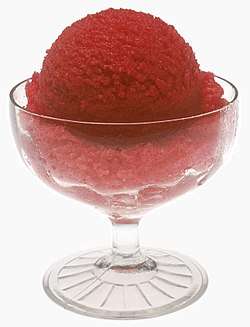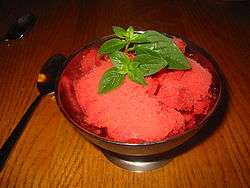Sorbet
 Raspberry sorbet | |
| Type | Frozen dessert |
|---|---|
| Main ingredients | Water, sugar, flavoring (fruit juice or purée, wine, or liqueur, and very rarely honey) |

Sorbet is a frozen dessert made from sweetened water with flavoring (typically fruit juice or fruit purée, wine, liqueur, or very rarely, honey).
Background
The word sherbet enters Italian as sorbetto which later becomes sorbet in French. The first Western mention of sherbet is an Italian reference to something that Turks drink. In the 17th-century, England began importing "sherbet powders" from Ottoman Empire made from dried fruit and flowers mixed with sugar.[1] By 1662, a coffeehouse in London advertised the availability of "sherbets made in Turkie of Lemons, Roses and Violets perfumed".[2] In 1670, Café Procope opened in Paris and began selling sorbet.[3] (In the modern era sherbet powder is still popular in the UK.) When Europeans figured out how to freeze sherbet they began making sorbetto by adding fruit juices and flavorings to a frozen simple syrup base. In the US sherbet generally meant an ice milk, but recipes from early soda fountain manuals include ingredients like gelatin, beaten egg whites, cream, or milk.[1]
Agraz is a type of sorbet that is usually associated with the Maghreb and north Africa. It is made from almonds, verjuice, and sugar. It has a strongly acidic flavour, because of the verjuice. (Larousse Gastronomique)
Givré (French for "frosted") is the term for a sorbet served in a frozen coconut shell or fruit peel, such as a lemon peel.
Preparation
Like granitas and other ices, sorbet can be made without an ice cream maker. Alcohol, honey or corn syrup can be added to lower the freezing point and make softer sorbets.[3]
Variations
Mulled wine sorbet can be made with red wine, orange, lemons, mulling spices, ruby port, and egg whites. Muscat sorbet is made with dessert wine, lemon juice, and egg whites.[4]
Terminology
American
Commercially produced sherbet in the United States is defined in the Code of Federal Regulations as a frozen product containing one or more optional dairy products.[5] Sorbet, on the other hand, is a made with sweetened ice and no dairy; it's similar to Italian ice, but made with real fruit instead of imitation flavoring.[6][7]
Homemade sherbets do not always contain dairy. Early 20th-century American recipes for sherbet include some versions made with water. The American Kitchen Magazine from 1902 distinguishes "water ices" from sherbets, explaining that "sherbets are water ices frozen more rapidly, and egg white or gelatin is often added to give a creamy consistency". In one recipe for pineapple sherbet, water may be used in place of milk. It also separately discusses "milk sherbets".[8]
According to The American Produce Review (1913) "Sherbet is a frozen product made from water or milk, egg whites, sugar, lemon juice and flavoring material". Sherbets are made from a base of "plain ice" which is water, sugar, egg whites, and lemon juice.[9]
Canada
In Canada, sorbet, which is known as sherbet, is defined as a frozen food; rather than ice cream or ice milk which are made from a milk product. A typical Canadian Sherbet possibly contains water, a sweetening agent, fruit or fruit juice, citric or tartaric acid, flavouring preparation, food colour, sequestering agent, lactose. More limitations include the requirement of not containing more than 5% milk solids, such as milk fat, and no less than 0.35% acid. The acid levels is determined by titration, the chemical process of measuring presence of certain components. Sherbet's acidity is usually expressed as lactic acid.
All of the above criteria are needed for the product to be considered as sherbet in Canada which is regulated by the Government of Canada under The Food and Drug Regulations.
See also
References
| Wikimedia Commons has media related to Sorbets. |
| Look up sorbet in Wiktionary, the free dictionary. |
Notations
- Lang, Jenifer Harvey, ed. (1988). "Agraz". Larousse Gastronomique: The New American Edition of the World's Greatest Culinary Encyclopedia. New York: Crown Publishers. ISBN 0517570327. OCLC 777810992.
Footnotes
- 1 2 Weir, Robin; Quinzio, Jeri (2015-07-23). "Sherbet". The Oxford Companion to Sugar and Sweets. Oxford University Press. ISBN 978-0-19-931339-6. Retrieved 2018-07-20 – via Oxford Reference. (Subscription required (help)).
- ↑ Jurafsky, Dan (2014-09-15). The Language of Food: A Linguist Reads the Menu. W. W. Norton & Company. ISBN 978-0-393-24587-5.
- 1 2 Pappas, Lou Seibert (1997-04). Sorbets and Ice Creams: And Other Frozen Confections. Chronicle Books. p. 11-15. ISBN 978-0-8118-1573-4. Check date values in:
|date=(help) - ↑ Liddell, Caroline; Weir, Robin (1996-07-15). Frozen Desserts: The Definitive Guide to Making Ice Creams, Ices, Sorbets, Gelati, and Other Frozen Delights. Macmillan. ISBN 978-0-312-14343-5.
- ↑ "Requirements for Specific Standardized Frozen Desserts". Accessdata.fda.gov. 2013-04-01. Retrieved 2014-08-09.
- ↑ Gallery, Christine (12 June 2017). "What's the Difference Between Sherbet and Sorbet?". The Kitchn. Archived from the original on 2017-02-12. Retrieved 4 July 2017.
- ↑ Marshall, Robert T.; Goff, H. Douglas; Hartel, Richard W. (2003). Ice Cream. Springer Science & Business Media. ISBN 978-0-306-47700-3.
- ↑ The American Kitchen Magazine. Home Science Publishing Company. 1902.
- ↑ The American Produce Review. 1913.